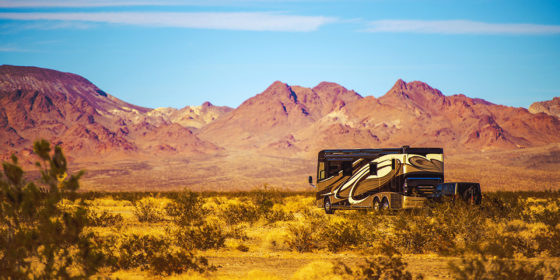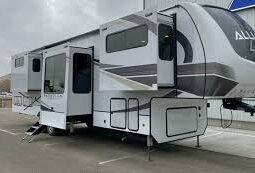Best RV for Surviving A Zombie Apocalypse
8 min read
It’s the end of the world as we know it. The living dead are taking over! The cities are overrun. There’s nowhere to hide. What do you do now?
You could:
a) Stay in your home and eventually become one of the undead yourself
b) Make a run for it in your car, join the legions trapped on the highways, and eventually become one of the undead yourself or
c) Hit the road in your trusty home-on-wheels, go overland, and avoid the zombie hordes.
You picked C? Phew! That’s our choice, too. But which RV is best for surviving a zombie apocalypse? RVT takes a look at some of your options and why they may (or may not) work.
1. Class A Diesel Motorhome
Class A Diesel Motorhome
This looks like it would be a no-brainer, right? The largest and most powerful of the motorized classes, the Class A diesel motorhome could likely run over the hordes without breaking a sweat. Up to 450 sq. ft of luxury on wheels. Huge fridge. Glass shower. Porcelain toilet. You can take your whole family, and maybe a friend or two as well. There’s lots of storage for zombie-fighting tools. Add a solar kit, a generator, propane tanks, and you’re set!
But wait! Bigger isn’t always better. Big size = big weight. You’re looking at zero-to-sixty in about 30 seconds. Plenty of time for the zombie hordes to jump onto the rear ladder. Big fridge? Not needed, my friend. There isn’t much fresh food available where you’re going. That fancy bathroom? No hookups available. All that elegance also isn’t ideal for going overland. These luxury bus-style cruisers are meant for highways, not offroading. And then there’s the gas. At roughly 7-13 mpg, you won’t get very far before you need to fill up at the nearest deserted, gasless fuel station. If you can’t fill up, you can’t even attempt an off-road escape.
2. Class C Motorhome
Class C Motorhome
Similar to the Class A, but with the truck-style front and over-cab sleeping. Not quite as large, so it should be more agile, right? Plus, it has all the comforts of home, good storage space, and can hold your whole family.
All true, but the Class C motorhome is still bulky and not particularly fast out of the gate—those pesky undead could probably climb that ladder. With gas mileage at around 14-18 mpg, you can get a little further than with a Class A, but possibly not far enough. Also, the Class C isn’t as powerful, so running over zombies won’t be as simple. Sure, you could trick it out with a few mods like a bull bar and some nobbier tires, but it still isn’t ideal for overlanding (off-roading + camping) deep in the backcountry.
3. Class B Motorhome
Class B Motorhome aka Camper Van
Jack be nimble, this one has some promise! Similar in size to the family van, the Class B motorhome typically offers some elegant appointments, along with a small kitchen and a bed for sleeping. Plus, these nimble camper vans will go zero to sixty in about a third of the time as the heavyweight diesel pusher. With gas mileage at 18-25 mpg, you can definitely go the distance. Add a composting toilet and a solar kit and away you go! #zombievanlife
But, hold on now. While they’re compact, nimble, and can weave around the hordes, if not outright run them over, the Class B is typically built for two. Great for solos or a couple, but families of more than three (parents plus a young child) usually won’t fit. Storage will also be quite limited. Another thing to consider: while FWD camper vans are excellent for boondocking, most aren’t made for serious overlanding. If you need to go high or deep, these compact homes on wheels may find it challenging.
4. SUV and Pop Up Trailer
Pop-up Trailer aka Tent Trailer or Folding Trailer
Pop-up trailers are lightweight, collapsible, easy to set up, you can take your family along (some models sleep up to eight), and you’ll have an SUV! Sport utility vehicles are often more fuel efficient than a truck, plus they’re reasonably agile and have plenty of seating. What’s not to love?
We hate to say it, but those tent-like canvas sides aren’t as sturdy as their hard-sided cousins. A determined creature could possibly get inside, so it’s probably not the ideal choice for keeping out the zombie hordes. Storage is also limited, and these lightweight folding trailers typically aren’t designed for swerving through traffic or heading off road.
5. Truck and Fifth Wheel
Truck with Fifth Wheel Trailer
A classic combination! You have a minimum 1/2 ton pickup truck (¾ ton is often recommended), a sturdy fifth wheel trailer that hooks right into the truck bed, lots of storage space, slideouts, and luxury appointments. Plenty of room for kids, pets, and maybe even grandparents. This combo is powerful enough to plow through the hordes, especially if you have a bull bar on the front grille. Plus, if you have a toy hauler model, you have room for kayaks, ATVs, dirt bikes, or other ‘alternative’ vehicles. Add a solar kit, propane, and a generator, and it’s go time!
Before you get up and go though, this combination may not be as ideal as it appears. Like their Class A cousins, fifth wheels are large, heavy, and not as easy to camouflage as some of the smaller RV options. Narrow spaces and steep terrain will be difficult to navigate with these behemoths, as will winding through abandoned vehicles on the highway. Because of their weight, gas mileage isn’t great, so keep that in mind as well. The sooner you run out of gas, the sooner you can be overtaken.
6. Vehicle and Travel Trailer
Travel Trailer
This choice looks viable given the multiple options available! Travel trailers come in a variety of shapes and sizes, so they are often lighter than their fifth-wheel family members and offer more options for tow vehicles. A pickup truck, SUV, or possibly even a van could be used, depending on the vehicle’s towing capacity. They can sleep anywhere from 2-8, depending on size, offer decent storage space, and have most of the comforts of home. A bull bar for the front grille is useful for pushing the living dead out of the way and a solar kit will help extend your boondocking ability.
That said, travel trailers typically aren’t built for rough terrain. Larger models will have more difficulty in narrow spaces, on unpaved roads, or navigating through deserted vehicles. Smaller, lighter models will find off-road travel even more challenging. Toy hauler units will allow space for alternative vehicles like ATVs, but typically weigh in at the bulkier and heavier end of the scale. Gas mileage may also be an issue.
7. 4×4 Truck with Slide-In Camper
4×4 Truck with Slide-In Camper
Hello—this looks like a great option for the family! The truck camper slides right into the truck bed and typically sleeps up to six. No need to tow a bulky trailer. Offroading? No problem! Whatever the capabilities of the truck are the capabilities of the camper. You can easily weave through stalled traffic and tackle curbs, ditches, hills, or valleys. Add a bull bar on the front to help get past the undead, although you may be able to cruise over them without it, depending on truck size. The bathroom and kitchen might not be as useful without hookups, but take along a composting toilet, an ample solar kit, some dehydrated food (lighter and easier to store than canned), a flint for starting a campfire, a water filtration system, some batteries for your flashlights, plus any other items you’d normally take for an extended overland boondocking trip, and you’re set!
Don’t forget, truck campers are smaller than most other options since they have to fit in the truck bed. Storage is limited.
8. AWD Adventure Van
AWD Adventure Van
This option is a keeper too! Like the Class B motorhome, this RV style is a little larger than the family van. Typically, adventure vans have a modular layout rather than a fixed layout, making it easy to set it up the way you want it. Underbed storage may allow you to bring a mountain bike or two, or some extra battle gear. These highly customizable vans feature larger tires with deeper treads, higher ground clearance, and are built to handle rough terrain. Many have a pop-up top with extra sleeping room that allows them to sleep up to 4 people, making it a better choice for families than a regular camper van.
Features such as a solar shower and a composting or cassette toilet is typical, which works well in a world without RV hookups. Add an ample solar kit, some dehydrated food, a water filtration system, a flint for your campfire, plus anything else you’d typically take on a long-term, dry-camping excursion, and you’re good to go! Gas mileage is similar to the Class B motorhome. Keep in mind that, like truck campers, storage space is limited.
Adventure vans are often custom built to suit your lifestyle, but some RV manufacturers have also gotten on board. The Pleasure-Way Rekon 4×4, Winnebago Revel, Storyteller Overland AWD, and Sportsmobile Classic 4×4 are some fixed-layout models you could pick up at a dealership or via private sale.
If you want to bring in the heavy hitters, ultra-duty adventure vehicles like the Earthroamer LTi, the Global Expedition Vehicles Safari Adventure-XT 4×4 RV or the Earthroamer XV-HD will take you anywhere you want to go. Built for adventure extremists, these RVs will withstand almost anything you throw at them—and they have the price tag to match.
Conclusion
Is there a ‘best’ RV for surviving a zombie apocalypse? When it comes right down to it, any RV will do. If a Class A is sitting in your driveway when the undead come calling, by all means, use it! However, if there’s an option, we think the best RV for surviving a zombie apocalypse is a 4×4 Truck with Camper or an AWD Adventure Van. Both can handle rough terrain, be used for extended dry-camping, will fit more than two people, have some of the comforts of home, are hard-sided to keep out the zombie hordes, are nimble and easy to control, and may be more fuel efficient than many of the other RV types. Just remember: space is limited, so pack wisely.
What do you think? Do you agree with our choice? What would your ideal RV for a zombie apocalypse be and why? Let us know in the comments!
We hope you enjoyed this foray into the world of zombie apocalypses. If you’re looking for an AWD Adventure Van, Truck Camper, or any other RV to escape the undead, check out the latest listings at RVT.com.



